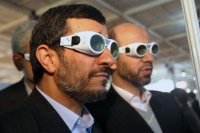Iranian engineers may begin to enrich uranium to a higher level in order to refuel an important research reactor in Tehran.
 |
| 'The future's so bright, I gotta wear shades': Ahmadinejad at the laser centre, one example of science and technology's role as a major source of pride for Iran (Image: president.ir) |
Reportedly, Iran was to notify the International Atomic Energy Agency (IAEA) of the plan today but an agency spokesperson told World Nuclear News it had "no information" on the matter and "cannot confirm anything."
In theory at least the effort would take Iran closer to self sufficiency in refuelling the Tehran research reactor, which produces isotopes for medical imaging procedures but will have to shut down without fresh fuel. However, it is not clear that Iran has the capability to actually manufacture new fuel elements even if could produce the main ingredient of sufficiently enriched uranium oxide.
Enrichment levels up to 20% are classified as 'low-enriched', and Iran already has about 1800 kilograms of uranium at less than 5% - the level required for a power reactor. However, the increase in enrichment within this category worries some observers that Iran may be ultimately aiming to reach weapons-usable levels of around 90%. All current stocks are under IAEA safeguards and so could not be diverted or further enriched without knowledge of the UN Security Council.
According to the Institute for Science and International Security, the Tehran research reactor was supplied and fuelled with 93% enriched uranium by the USA during the late 1960s. Argentine specialists converted it to use low-enriched fuel in the late 1980s but some irradiated original fuel remains in Iran.
The statement from Ahmadinejad is the latest move in a game of brinkmanship between Iran and the international community as led by the 5+1 group of China, France, Germany, Russia, the UK and USA. A previous plan to supply new research reactor fuel relying on Russian enrichment and French manufacture was rejected by Iran, which then tabled a revised version. At issue was the amount of Iran's uranium stockpile to be handed over at one time: The P5+1 wanted to do the job in one large shipment while Iran preferred several smaller swaps which maintained more of its overall holding for a longer time period.
Iran's reaction to the original plan is sadly in line with a recently published US intelligence report that concluded the country was "keeping open the option to develop nuclear weapons." The 2010 Annual Threat Assessment said "Iran has the scientific, technical and industrial capacity to eventually produce nuclear weapons, making the central issue its political will to do so."
Researched and written
by World Nuclear News




_91467.jpg)
_47120.jpg)

_23621.jpg)





